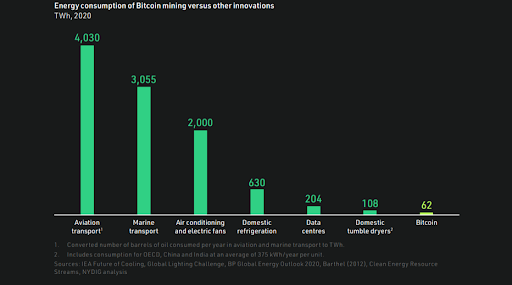Climate-Neutral Cryptos vs. Bitcoin: How Green Is the Future?
Critics say that Bitcoin consumes as much energy as a country like Greece and generates 300 kg of CO2 per each transaction. Others argue for public benefits of the first cryptocurrency: in developing countries suffocating from overinflation, it helps people save their money from depreciation.
Research shows that up to 50% of Bitcoin’s energy sources have become renewable to date. But here’s the thing: many newer digital coins are already built with sustainability in mind. Climate-neutral cryptocurrencies and their green initiatives are at the forefront of fighting climate change.

Is Bitcoin That Bad for the Environment?
When Bitcoin and other cryptocurrencies have started to consume considerable amounts of energy, they have quickly become the focus of many eco-activists around the world.
Why does Bitcoin consume so much?
Miners who add new blocks to the blockchain are financially incentivized – they are rewarded for approving Bitcoin transactions. To forge a block, they have to win a competition by finding the block hash faster than other miners. In Proof of Work, you win if you compute fast – which requires running powerful equipment. But there’s only one winner in the competition, and the energy that other miners consume is “wasted”. Many of them use fossil fuels because they are cheap.
What is the environmental impact of Bitcoin, exactly?
Here’s some data:
- Bitcoin consumes more electricity than Norway or Sweden and roughly the same amount as Greece.
- According to the Bitcoin Energy Consumption Index by Digiconomist, the first cryptocurrency generates 37 million of CO2 per year.
- One Bitcoin transaction produces 300 kilograms of CO2. The same amount is generated while burning 130 liters of gasoline or during a 1,600-kilometer car drive. This equals the emission from 750,000 Visa transactions.
Ethereum stats are a little better but still frightening: the network generates 12 million tons of CO2 each year and 27 kilograms per transaction (like burning 12 liters of gas does). Fortunately, Ethereum is changing its consensus algorithm to the Proof of Stake, and these numbers will soon become hundreds of times smaller.
This data has sparked fierce debate, and a call to limit or ban mining has emerged. In November 2021, Sweden’s top regulators said the country wouldn’t fulfill its obligations under the Paris Agreement unless mining is prohibited. In their open letter, regulators called for a EU-wide ban of mining.
Why is cutting Bitcoin’s СО2 emissions so hard?
If the ban goes live and miners leave Sweden, they will continue operations somewhere else, while the goal of the Paris Agreement is to reduce CO2 production worldwide. Data shows that after miners fled China, mining became dirtier: according to the Revisiting Bitcoin's Carbon Footprint study, the share of renewables decreased from 41.6% in 2020 to 25.1% in August 2021. Miners could seasonally use Sichuan and Yunnan hydropower plants in China, but now they leverage natural gas in the USA and the most carbon-intensive type of coal in Kazakhstan.
On the other hand, there’s a different study (Bitcoin Mining Council Report) that demonstrates: 57% of energy used in mining came from renewable sources in Q3 2021. However, research included carbon generation with carbon offsets, so methodological nuances are important when it comes to assessing Bitcoin’s impact.
Why can’t Bitcoin miners simply switch to renewable sources?
Green energy is simply more expensive than fossil fuels on average. Mining is a business, after all – and it aims to minimize expenses where possible. Governments could reduce the cost of renewables by law, but that would require high subsidy expenditures.
Could Bitcoin go PoS to reduce emissions?
Some eco activists claim that Bitcoin could simply switch to Proof of Stake – and that would solve the problem since the cryptocurrency would consume 99.99% less energy. In response to this, industry players say that this proposal is the result of a lack of understanding of how Bitcoin works.
“Bitcoin will never switch to a PoS consensus algorithm,” – says Max Kordek, CEO & Co-Founder of Lisk, in a comment to ChangeNOW. “Further, I believe Bitcoin should not switch to a PoS consensus algorithm. The world requires 100% censorship resistant and neutral money. Bitcoin is solving that and can become the global settlement layer. However, only with PoW.”
Moreover, Kordek believes that power grids can benefit from Bitcoin’s energy consumption. “Bitcoin miners can improve the stability of electricity grids by turning on mining when the demand for electricity is low and turning it off when the demand for electricity is high. Bitcoin miners can monetize the moments when the demand for electricity is low which allows the electricity grids to operate at near-max capacity at all times.”
Flaws of the Bitcoin’s eco debate
Bitcoin’s environmental impact is mostly criticized in developed countries where people have access to financial services, stable economies, and national currencies with relatively low inflation. In the meantime, in developing countries (where 80% of the world’s population lives), Bitcoin brings great value – it provides financial freedom and protects money from hyperinflation. The first cryptocurrency helps the unbanked even in developed countries.
Bitcoin’s impact debate may even seem hypocritical if we compare its harm with damage from other energy-consuming things. For instance, the first cryptocurrency consumes 1.5 times less energy than household tumble dryers in the USA alone (62 TWh a year against 108 TWh). The dryers are socially accepted, their useful feature is obvious to everyone (unlike Bitcoin’s, apparently), and no one urges to reduce dryers’ CO2 emission.
Max Kordek believes that cryptocurrency can improve its public perception by offering green solutions and taking care of the environment. “That will increase public acceptance and therefore make crypto more popular and widespread. Therefore, I see it as a vital part in achieving mainstream adoption,” – says the CEO of Lisk.

Here’s another case: in April 2022, the State of New York established a moratorium on mining that uses fossil fuel energy. Vitalik Buterin, known for his criticism of Bitcoin’s impact, roasted this decision. “The government picking and choosing which specific applications are an okay use of electricity or not is a bad idea,” said the co-founder of Ethereum. He was supported by Nic Carter, a crypto investor and entrepreneur: “Will red states respond and ban computation taking place in their borders used for pornography, Netflix, and Disney?”, said Carter.
Calls for change
“The environmental impact of crypto is an extremely important topic for the industry,” – says Max Kordek. The CEO of Lisk.explains that Ethereum’s transition to Proof of Stake “shows that this matter is treated very seriously.”
There have been some collaborative initiatives in the crypto community to mitigate environmental damage. One of them, the Crypto Climate Accord, was signed in 2021 by 200+ companies and individuals to reach net-zero operations by 2030, which implies switching to renewable sources of energy.
The Accord was just a voluntary agreement with no mechanism of enforcement, though. "It clearly is not working because the network actually got less green during the year,” said Alex de Vries, one of the authors of the Revisiting Bitcoin's Carbon Footprint study. “They need to have some kind of enforcement mechanism, then there may be some kind of reward,” the expert noted.
However, many large crypto platforms are eco-conscious without any enforcement. Let’s see what cryptocurrencies do for the environment and how major blockchains become climate-neutral.
5 Climate-Neutral Cryptocurrencies
Environmental discourse is usually about cutting greenhouse emissions, but this is no longer enough – we’ve gone too far in polluting the atmosphere. It is more productive to think of climate neutrality – an approach where you don’t only reduce CO2 production but also compensate for any remaining emissions (which makes you carbon-neutral) or even go beyond (carbon-negative). The latter implies removing gas from the atmosphere or supporting climate-oriented projects.
The recent Joe Biden’s executive order on cryptocurrency encourages “exploratory efforts to investigate the environmental benefits of distributed technologies.” The document is one step forward to focusing on projects that improve the climate, not only reduce carbon emissions. However, climate-neutral cryptocurrencies are already all around us, and here are some of the most notable ones.
Powerledger (POWR) – P2P solar energy trading

Some households produce energy with solar panels for domestic use. But what if an exceeding amount of electricity has been generated, and the producer wants to share it? This is where Powerledger comes on stage – an energy P2P trading platform. It introduces a system that replaces (or complements) legacy electric grids where energy passes only one-way – from power plants to users.
Powerledger allows people to track and trade energy in real-time. It creates a more sustainable grid where excess energy generated by solar panels and wind is not wasted but brings income to producers. The project has been operating since 2016 – first, it was based on the Ethereum network, but then migrated to the Powerledger Energy Blockchain on the carbon-neutral Solana network. POWR market capitalization is $109 million as of August 22, and the coin ranks 187th on CoinMarketCap.
Algorand – a green treasury for reforestation

Algorand is a layer-1 network for decentralized applications. It leverages the Proof of Stake consensus mechanism, which makes it carbon-negative – the platform not only minimizes CO2 emissions but also contributes to reducing the amounts of greenhouse gas in the atmosphere.
A special smart contract retains a fraction from each Algorand transaction to offset the platform’s carbon footprint. The money goes to a “green treasury” maintained in partnership with ClimateTrade – a company that helps organizations compensate for their environmental impact in a cost-efficient way. This way Algorand funds reforestation in Colombia, protects forests in Cambodia, and produces wind energy in Mexico. Environmental responsibility helps Algorand gain adoption among eco-conscious brands, creators, and developers.
Near protocol – 200K times greener than Bitcoin

NEAR is a blockchain for dApps that addresses the flaws of the first-generation L1 platforms. It has implemented the PoS for greater throughput and scalability, introduced human-readable addresses, and ensured sustainable operation of the blockchain. NEAR consciously measures its carbon footprint and reduces it through green initiatives, which makes the platform carbon-neutral.
In 2021, NEAR partnered with a climate solutions provider South Pole. This step helps decrease the blockchain’s environmental impact to a minimum and offset the remaining CO2 emissions. Currently, NEAR generates 174 tons of CO2 per year – 200,000 times less than Bitcoin does. And this is the key advantage of Proof of Stake – as the NEAR network’s transaction count grows, the blockchain’s carbon footprint increases insignificantly.
NEAR supports reforestation projects, which makes its blockchain climate-neutral. By sending transactions in the NEAR network, you help plant trees in Colombia, Zimbabwe, and the USA.
Solana – making your fridge green

In December 2021, Solana announced becoming carbon-neutral thanks to its carbon offsets. But it wasn’t due to reforestation or wind energy – Solana Foundation supports refrigerant destruction, one of the most efficient ways to compensate for carbon emissions. This method targets fridges and air conditioners: it eliminates hydrofluorocarbons (HFCs) that they use, substances that trap heat in the atmosphere 1–9 thousand (!) times more effectively than CO2.
Even without taking carbon offsets into account, Solana is one of the greenest blockchains out there. Research showed that it uses less energy than needed for two Google searches. This is 1,939 joules – 400,000 times less than one Ethereum transaction consumes (770,600,000 J) and 3,800,000 times less than one Bitcoin’s (7,412,400,000 J).
Filecoin Green

Filecoin is a decentralized P2P storage system – providers contribute their free disk space where users can store their data in a secure way. Filecoin Green is an initiative that strives to measure the environmental impacts of Filecoin and drive them below zero: it allows storage providers to publicly share their source of electricity and show that it comes from renewable sources and was generated in their area. Besides energy attribute certificates, Filecoin Green is building a Web3-native global marketplace for renewable energy and mobilizes capital to generate more solar power in the USA.
How Green Is the Future of Crypto?
All major layer-1 networks that are gaining traction today have been built on the eco-friendly Proof of Stake consensus mechanism. The only exception to this is Ethereum, but the platform is to abandon Proof of Work by the end of 2022. There is a great abundance of other types of coins, but it’s hard to imagine anyone creating and rapidly developing an energy-consuming PoW crypto in 2022.
Consequently, today’s main objective is to make the existing mineable cryptocurrencies greener. There is perhaps only one way to ensure this – to make it more profitable for miners to use renewable sources of energy, that is, make renewables cheaper. And if humanity succeeds in this, many businesses and individuals will choose green electricity, not only miners. Everyone will benefit from it – so making low-carbon energy cheaper sounds like an ultimate goal for sustainable development.



